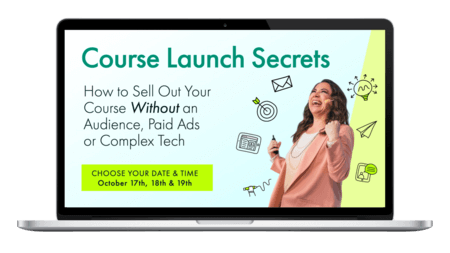Are you ready to experiment with online marketing but feeling overwhelmed? You’re in the right place.
This beginner’s guide breaks down the essentials of digital marketing, making it easy to understand and implement.
Whether you’re a small business owner or an aspiring marketer, we’ll help you navigate the online world confidently.
What is Online Marketing?
Online marketing uses the internet and digital platforms to promote products, services or brands.
Depending on your business model, your online marketing strategy might cover:
- search engine marketing
- content marketing
- social media marketing
- email marketing
- PPC advertising
- affiliate marketing
- influencer marketing
Online marketing is powerful because it lets even small businesses reach people worldwide. It offers more targeted, interactive and measurable campaigns than traditional marketing methods like print or TV ads.
And the best part? You can often see exactly how well your marketing campaigns are working. Then, you can adapt your approach for better results.
What are the Basics of Online Marketing?

Before diving into specific strategies, it’s essential to understand the foundation of online marketing. These basics will help you build a powerful marketing strategy as you promote your business online.
Understanding Your Audience
Knowing your audience is crucial. You’re not talking to “everyone on the internet.” Your audience is the specific group of people most likely to be interested in your offer.
Start by thinking about your ideal customer. What are their age, interests and challenges? Where do they hang out online? What kind of content do they enjoy?
Once you understand your audience, you can create content and ads that speak directly to them.
Understanding your audience isn’t a one-time task. Consumer behaviors change over time. Keep listening to your customers and be ready to adjust your approach.
Setting Clear Marketing Goals
Having clear goals gives you a roadmap for your online marketing journey.
Start by thinking about what you want to achieve. Do you want people to:
- Visit your website?
- Buy a specific product?
- Sign up for your email list?
Make sure your goals are SMART: Specific, Measurable, Achievable, Relevant and Time-bound.
For example, instead of saying, “I want more website visitors,” you might set a goal like, “I want to increase my website traffic by 20% in the next three months.” This gives you a target and a deadline.
Your goals should guide your marketing decisions. Regularly checking your progress against your goals lets you see what’s working and what needs to be adjusted.
Choosing the Right Online Marketing Channels
With so many digital marketing channels available, choose the ones that will work best for your business.
Start by looking at where your audience spends their time online.
Are they active on Facebook? Do they prefer email? Do they search for businesses like yours on Google? Your audience research will help you answer these questions.
Then, think about your business and what you’re trying to achieve.
If you’re a B2B company, LinkedIn might be a good fit. If you sell visually appealing products, Instagram could be ideal.
Consider your resources.
Some channels, like social media, are time-consuming, though marketing automation can help. Others, like pay-per-click advertising, require a budget.
What are the Key Online Marketing Strategies for Beginners?
Now that we’ve covered the basics, let’s explore some specific strategies. These are tried-and-true methods that even beginners can implement.
Content Marketing

Content marketing is creating and sharing valuable information that engages your audience. Instead of directly promoting products, it focuses on building trust and showcasing your expertise.
Create High-Quality Content
To be successful with content marketing, you have to create content your audience wants to read, watch or listen to. These could be blog posts, videos, podcasts, infographics or social media posts.
Start by thinking about what your audience wants to know. What questions do they have? What problems are they trying to solve? Your content should provide answers and solutions.
Vary your content types. Some people prefer reading, while others enjoy videos. By offering a mix, you can cater to different preferences and keep your content interesting.
Provide value. Whether you’re educating, entertaining or inspiring your audience, make sure they walk away feeling like they’ve gained something from your content.
Optimize for SEO
Search Engine Optimization, or SEO, helps search engines find and understand your content.
There are three categories of SEO.
- On-page SEO: Optimizes individual web pages by incorporating relevant keywords, title tags, meta descriptions, and header tags (H1, H2, etc.) to rank higher in search results.
- Off-page SEO: Involves actions outside your website, primarily building high-quality backlinks to boost search rankings.
- Technical SEO: Focuses on your website’s backend, including site speed, mobile-friendliness and ensuring an easy-to-crawl site structure for search engines.
While SEO is important, your primary goal should always be to create valuable content for your human readers.
Social Media Marketing

Social media marketing uses social platforms to connect with your audience and build brand awareness. It’s a terrific way to engage with customers and showcase your brand’s personality.
Choose the Right Platforms
Each social media platform is different; you want to be where your target audience is most active.
Facebook is often a good starting point for many businesses because of its large, diverse user base. It’s great for sharing a variety of content types and building community.
If your business relies on strong visuals, Instagram is effective. It’s perfect for showcasing products and engaging with audiences.
LinkedIn is the go-to platform for B2B companies or professionals offering services.
X (formerly Twitter) is helpful for businesses that want to stay on top of trends and engage in real-time conversations.
TikTok can be powerful for targeting younger audiences or for brands with creative content.
Build an Engaged Audience
Building an engaged audience on social media takes time.
Start by posting consistently. The frequency will vary based on the platform and your resources.
Encourage interaction by asking questions or running polls. When followers comment or message you, respond promptly and in a friendly manner.
Share diverse content to keep your feed interesting. Use images, videos and text posts.
Be genuine. People connect with authenticity, not sales pitches.
Social Media Advertising for Beginners
Organic reach can be tough, but social media advertising offers a way to reach your audience effectively. Start with a small daily budget and adjust as you see results.
Begin by setting clear goals for your ads. Choose ad formats that fit your objectives and content. Use eye-catching visuals and snappy copy that clearly communicates your value.
Test multiple ad versions with slight variations to see which performs best, and monitor the results to fine-tune your approach.
Social media advertising is a learning process — start small, track your progress and adjust your strategy as you discover what works for your business.
Email Marketing

Email marketing is a powerful tool for building customer relationships, promoting your products or services and driving traffic to your website. And it offers an excellent return on investment.
Build an Email List
Start by offering valuable incentives, like a free guide or discount code, to encourage sign-ups.
Clearly communicate what subscribers can expect, whether it’s weekly tips, exclusive offers or company updates.
Use a double opt-in process to have subscribers confirm their email addresses for a higher-quality list.
Craft Effective Email Campaigns
The best emails you’ll write come from understanding your audience and their needs.
Try segmenting your email list based on factors like purchase history, interests or engagement level. It’s the easiest way to send targeted, relevant content to your subscribers.
Use attention-grabbing subject lines to encourage opens, but avoid clickbait tactics that could disappoint readers.
Personalization can improve your email performance. Use subscribers’ names and tailor content based on their preferences or past interactions with your business.
Include a clear call-to-action (CTA) in each email. Make it easy for them to take that next step.
Measure Email Campaign Success
Measuring the success of your email campaigns is how you’ll improve your strategy. Most email marketing platforms provide analytics to help you understand your emails’ performance.
The click-through rate shows how many people clicked on links in your email. This reveals how engaging your content and CTAs are.
The conversion rate shows how many people took the desired action after reading your email.
Bounces happen when emails cannot reach the recipient’s inbox. A high bounce rate might mean you need to clean up your email list.
The unsubscribe rate shows how many people opt out of your emails. Expect some unsubscribes, but a high rate might indicate your content isn’t meeting subscribers’ expectations.
Test elements like subject lines, content types and sending times to see what resonates best with your audience.
Pay-Per-Click Advertising (PPC)

Pay-per-click advertising is an online marketing method where you pay each time a user clicks on one of your ads. You’re buying site visits rather than waiting for organic traffic, so it’s an effective way to quickly drive targeted traffic to your website.
What is PPC?
PPC advertising works on an auction system. You bid to have your ad appear when someone searches for specific keywords related to your business. It’s commonly used on search engines and social media platforms.
The beauty of PPC is that you only pay when someone clicks on your ad. You’re not spending money on people who see your ad but aren’t interested.
Setting Up Your First Campaign
First, choose your platform. Google Ads is the most popular search engine advertising tool, while Facebook Ads are great for social media.
Next, define your campaign goals. Are you looking to increase sales or generate leads? Your goals will influence your campaign setup and success metrics.
Keyword research is vital for PPC. Use keyword planning tools to find search terms relevant to your business.
Write ad copy that highlights your offer. Include a strong CTA that tells people what to do next. Optimize the landing page for conversions.
Set a budget you’re comfortable with. Start small and increase your spending as you learn what works. Most platforms let you set daily budgets and maximum bids for each click.
Optimizing PPC Campaigns
PPC requires ongoing management and optimization to get the best results.
Review your campaign performance regularly. Look at metrics like click-through rate, conversion rate and cost per conversion.
Refine your keyword list based on performance. Pause keywords that aren’t performing well and consider adding new ones.
Test variations of your ads to see what resonates best with your audience. Try different headlines, descriptions and CTAs. Many platforms offer A/B testing tools to make this easier.
Monitor your quality score. Many PPC platforms use this metric to determine your ads’ relevance and value. A higher quality score can lead to better ad positions and lower costs.
Don’t be afraid to make changes, but give your campaigns enough time to gather meaningful data before making significant adjustments.
What are Common Online Marketing Mistakes to Avoid?

While online marketing offers many opportunities, it’s easy to fall into certain traps.
Let’s look at three pitfalls you’ll want to avoid.
Ignoring Mobile Users
Overlooking mobile users is a costly mistake. Many people are browsing, shopping and interacting on their smartphones. If your website isn’t mobile-friendly, you’re likely losing potential customers.
Consider how your emails and social media content appear on mobile devices. Are your fonts easy to read? Are your images clear?
Not Having a Clear Strategy
Set goals with specific, measurable objectives for your digital marketing campaigns. Concrete targets keep you on track.
Look at consumer behavior to find the best ways to reach your target audience. Make a plan for your content and digital marketing platforms.
Review and adjust your strategy based on your results.
Focusing on Quantity Over Quality
It’s tempting to prioritize quantity over quality. But low-quality content or ads do more harm than good.
Instead, focus on creating relevant content that serves your audience’s needs. Posting one thoughtful, well-crafted piece of content is better than several rushed, mediocre ones.
The same goes for your email list or social media followers. A smaller, engaged audience is far more valuable than a large, uninterested one.
Your Journey to Online Marketing Success Starts Now
We’ve covered the essentials of online marketing.
Now it’s your turn.
What’s your biggest challenge in online marketing? Share in the comments below!
Before you go…
Get Instant Access to my FREE Dopamine Button Guide!
Inside, you’ll discover 3 little-known brain hacks that skyrocket your course engagement & sales…
Here’s the thing: the “old way” of designing and launching courses just isn’t cutting it anymore.
If you want to attract students who buy and keep buying (not to mention send referrals your way!)…
You need to do things differently.
Enter the Dopamine Button — the super-secret button in your students’ brains that you can leverage to create incredible results for them AND repeat sales for you.




























Leave a Comment